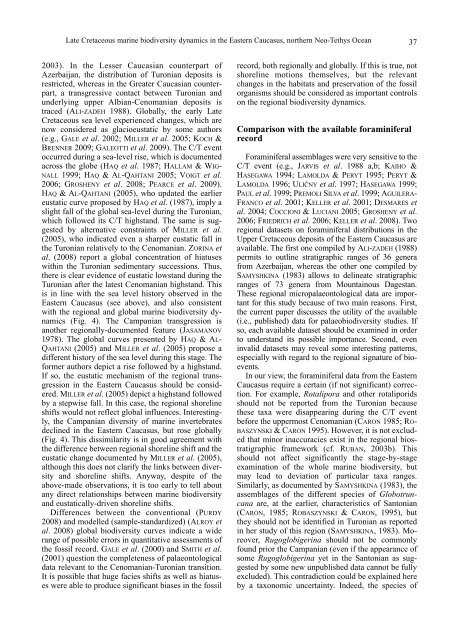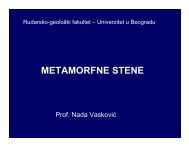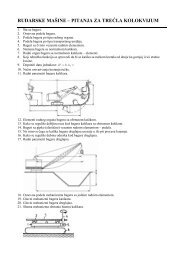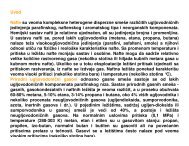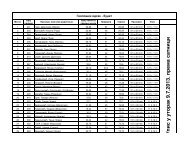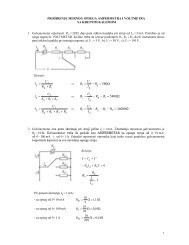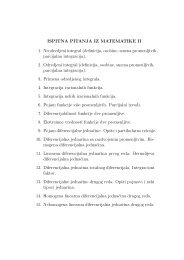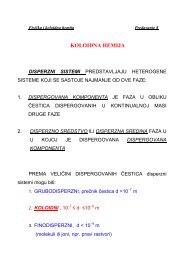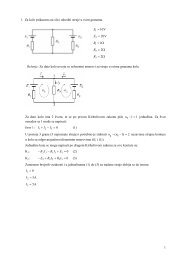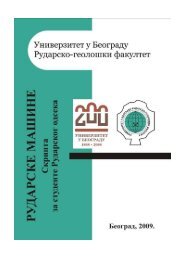KÑига LXXII
KÑига LXXII
KÑига LXXII
You also want an ePaper? Increase the reach of your titles
YUMPU automatically turns print PDFs into web optimized ePapers that Google loves.
Late Cretaceous marine biodiversity dynamics in the Eastern Caucasus, northern Neo-Tethys Ocean 37<br />
2003). In the Lesser Caucasian counterpart of<br />
Azerbaijan, the distribution of Turonian deposits is<br />
restricted, whereas in the Greater Caucasian counterpart,<br />
a transgressive contact between Turonian and<br />
underlying upper Albian-Cenomanian deposits is<br />
traced (ALI-ZADEH 1988). Globally, the early Late<br />
Cretaceous sea level experienced changes, which are<br />
now considered as glacioeustatic by some authors<br />
(e.g., GALE et al. 2002; MILLER et al. 2005; KOCH &<br />
BRENNER 2009; GALEOTTI et al. 2009). The C/T event<br />
occurred during a sea-level rise, which is documented<br />
across the globe (HAQ et al. 1987; HALLAM & WIG-<br />
NALL 1999; HAQ & AL-QAHTANI 2005; VOIGT et al.<br />
2006; GROSHENY et al. 2008; PEARCE et al. 2009).<br />
HAQ & AL-QAHTANI (2005), who updated the earlier<br />
eustatic curve proposed by HAQ et al. (1987), imply a<br />
slight fall of the global sea-level during the Turonian,<br />
which followed its C/T highstand. The same is suggested<br />
by alternative constraints of MILLER et al.<br />
(2005), who indicated even a sharper eustatic fall in<br />
the Turonian relatively to the Cenomanian. ZORINA et<br />
al. (2008) report a global concentration of hiatuses<br />
within the Turonian sedimentary successions. Thus,<br />
there is clear evidence of eustatic lowstand during the<br />
Turonian after the latest Cenomanian highstand. This<br />
is in line with the sea level history observed in the<br />
Eastern Caucasus (see above), and also consistent<br />
with the regional and global marine biodiversity dynamics<br />
(Fig. 4). The Campanian transgression is<br />
another regionally-documented feature (JASAMANOV<br />
1978). The global curves presented by HAQ & AL-<br />
QAHTANI (2005) and MILLER et al. (2005) propose a<br />
different history of the sea level during this stage. The<br />
former authors depict a rise followed by a highstand.<br />
If so, the eustatic mechanism of the regional transgression<br />
in the Eastern Caucasus should be considered.<br />
MILLER et al. (2005) depict a highstand followed<br />
by a stepwise fall. In this case, the regional shoreline<br />
shifts would not reflect global influences. Interestingly,<br />
the Campanian diversity of marine invertebrates<br />
declined in the Eastern Caucasus, but rose globally<br />
(Fig. 4). This dissimilarity is in good agreement with<br />
the difference between regional shoreline shift and the<br />
eustatic change documented by MILLER et al. (2005),<br />
although this does not clarify the links between diversity<br />
and shoreline shifts. Anyway, despite of the<br />
above-made observations, it is too early to tell about<br />
any direct relationships between marine biodiversity<br />
and eustatically-driven shoreline shifts.<br />
Differences between the conventional (PURDY<br />
2008) and modelled (sample-standardized) (ALROY et<br />
al. 2008) global biodiversity curves indicate a wide<br />
range of possible errors in quantitative assessments of<br />
the fossil record. GALE et al. (2000) and SMITH et al.<br />
(2001) question the completeness of palaeontological<br />
data relevant to the Cenomanian-Turonian transition.<br />
It is possible that huge facies shifts as well as hiatuses<br />
were able to produce significant biases in the fossil<br />
record, both regionally and globally. If this is true, not<br />
shoreline motions themselves, but the relevant<br />
changes in the habitats and preservation of the fossil<br />
organisms should be considered as important controls<br />
on the regional biodiversity dynamics.<br />
Comparison with the available foraminiferal<br />
record<br />
Foraminiferal assemblages were very sensitive to the<br />
C/T event (e.g., JARVIS et al. 1988 a,b; KAIHO &<br />
HASEGAWA 1994; LAMOLDA & PERYT 1995; PERYT &<br />
LAMOLDA 1996; ULIČNY et al. 1997; HASEGAWA 1999;<br />
PAUL et al. 1999; PREMOLI SILVA et al. 1999; AGUILERA-<br />
FRANCO et al. 2001; KELLER et al. 2001; DESMARES et<br />
al. 2004; COCCIONI & LUCIANI 2005; GROSHENY et al.<br />
2006; FRIEDRICH et al. 2006; KELLER et al. 2008). Two<br />
regional datasets on foraminiferal distributions in the<br />
Upper Cretaceous deposits of the Eastern Caucasus are<br />
available. The first one compiled by ALI-ZADEH (1988)<br />
permits to outline stratigraphic ranges of 36 genera<br />
from Azerbaijan, whereas the other one compiled by<br />
SAMYSHKINA (1983) allows to delineate stratigraphic<br />
ranges of 73 genera from Mountainous Dagestan.<br />
These regional micropalaeontological data are important<br />
for this study because of two main reasons. First,<br />
the current paper discusses the utility of the available<br />
(i.e., published) data for palaeobiodiversity studies. If<br />
so, each available dataset should be examined in order<br />
to understand its possible importance. Second, even<br />
invalid datasets may reveal some interesting patterns,<br />
especially with regard to the regional signature of bioevents.<br />
In our view, the foraminiferal data from the Eastern<br />
Caucasus require a certain (if not significant) correction.<br />
For example, Rotalipora and other rotaliporids<br />
should not be reported from the Turonian because<br />
these taxa were disappearing during the C/T event<br />
before the uppermost Cenomanian (CARON 1985; RO-<br />
BASZYNSKI & CARON 1995). However, it is not excluded<br />
that minor inaccuracies exist in the regional biostratigraphic<br />
framework (cf. RUBAN, 2003b). This<br />
should not affect significantly the stage-by-stage<br />
examination of the whole marine biodiversity, but<br />
may lead to deviation of particular taxa ranges.<br />
Similarly, as documented by SAMYSHKINA (1983), the<br />
assemblages of the different species of Globotruncana<br />
are, at the earlier, characteristics of Santonian<br />
(CARON, 1985; ROBASZYNSKI & CARON, 1995), but<br />
they should not be identified in Turonian as reported<br />
in her study of this region (SAMYSHKINA, 1983). Moreover,<br />
Rugoglobigerina should not be commonly<br />
found prior the Campanian (even if the appearance of<br />
some Rugoglobigerina yet in the Santonian as suggested<br />
by some new unpublished data cannot be fully<br />
excluded). This contradiction could be explained here<br />
by a taxonomic uncertainty. Indeed, the species of


